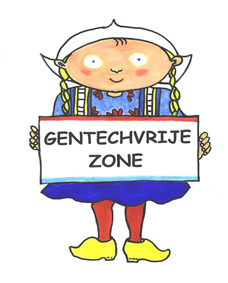Fundamental arguments against genetic manipulation the proponents don’t want you to know, because they expose their racket and criminal gamble with the health of the people and the environment.
== Omschrijving ==
Pamflet, argumenten tegen genetische manipulatie, uitspraken van wetenschappers.
== Auteur(s) ==
Jan Storms
== Uitgever ==
Ekopark Lelystad.
== Volledige tekst ==
Fundamental arguments against genetic manipulation the proponents don’t want you to know, because they expose their racket and criminal gamble with the health of the people and the environment.
* 1 Genetic engineering is based on simplistic, pseudo-scientific assumptions that were invented more than forty years ago. The development of knowledge in genetics and biology has invalidated many of the most fundamental assumptions – and with them the claims that genetic manipulation is safe. E.g.:there is no simple causal relationship between DNA and discrete traits of an organism.
* 2 Application of these pseudo-scientific assumptions inevitably causes damage to the manipulated organisms.
* 3 It is not possible to predict what damage a genetic transformation causes. The intervention is largely arbitrary and our knowledge of the interactions with the target organism is inadequate.
* 4 The damage to engineered organisms manifests itself in practice, even in crops that are commercially grown and consumed by people and livestock.
* 5 According to eyewitness reports, several species of animals avoid GM food if they have a choice.
* 6 Contact with some genetically engineered products may damage the health of people working with them or living close by.
* 7 Genetically engineered food has been shown to be harmful to the health of animals, with changes in the immune system, organ damage, gastrointestinal distress, reproductive problems, etc.
* 8 Part of the (increase of) allergies and chronic diseases is due to the consumption of food and laundry products that are genetically engineered or produced using genetic engineering.
——
According to the current understanding of genetics and biology, the practice of genetic manipulation is fundamentally flawed.
Earlier this year, the ministry of VROM commissioned the production of a map listing the arguments of consumers for and against genetically manipulated crops.
The core scientific arguments against these junk science based crops were presented to the makers, but each and every fundamental argument against genetic manipulation was banned from the map.
Because you have the right to know and decide for yourself, we present the banned scientific and health arguments here.
‘Monsanto should not have to vouchsafe the safety of biotech food. Our interest is in selling as much of it as possible.’-Phil Angell, (now former) director of corporate communications at Monsanto
After reviewing more than 600 scientific publications, world renowned biologist Pushpa M. Bhargava concludes that genetically modified organisms (GMOs) are a major contributor to the sharply deteriorating health of Americans.-Pushpa M. Bhargava, former director of the Centre for Cellular and Molecular Biology, vice-chairman of the National Knowledge Commission, India
‘I have the feeling that science has transgressed a barrier that should have remained inviolate L..) you cannot recall a new form of life […] It will survive you and your children and your children’s children. An irreversible attack on the biosphere is something so unheard of, so unthinkable to previous generations, that I could only wish that mine had not been guilty of it.’-Erwin Chargaff, Professor Emeritus of Biochemistry, Columbia University, and discoverer of’Chargaff’s Rules, which laid the scientific foundation for the discovery of the DNA double helix
‘Genes are arranged along the DNA in groups or ‘families’. The function of a given gene in a group is dependent on all the other genes that are present within the same family. Furthermore, the genetic activity in one family of genes can affect the function of genes in other groups of genes. It is also clear that genes and the proteins that they give rise to, have co-evolved together to form an extremely intricate, interconnected network of finely balanced functions, the complexities of which we are only just beginning to understand and appreciate.’ Dr. Michael Antoniou, Senior Lecturer in Molecular Genetics, GKT Medical School, Guy’s Hospital, London.
‘Genomes are selected in the entirety of their expression. In ways we barely comprehend, the genes within a species are interconnected and interact as an integrated whole. When a gene from an unrelated species is introduced, the context within which it finds itself is completely changed. If a taiko drum is plunked in the middle of a symphony orchestra and plays along, it is highly probable the resultant music will be pretty discordant. Yet based on studies of gene behavior derived from studies within a species, biotechnologists assume that those rules will also apply to genes transferred between species. This is totally unwarranted.
Context is crucial. Yet genetic manipulation of food ignores millions of years of evolutionary context, and that could have serious implications in the future. We aren’t dealing with an insignificant change to our diets here, we’re dealing with a revolutionary technology being used in our food supply – affecting us, future generations and the ecosystems on which we depend. It is bad science to assume roles of heredity acquired after thousands of years of agriculture are equally
applicable in the infant field of transgenic strains.’-David T. Suzuki Ph. D., Professor Emeritus, University of British Columbia, his 1976 textbook ‘An Introduction to Genetic Analysis’ (with AJ.F. Griffiths), remains the most widely used genetics text book in the U.S.
‘Swapping genes between organisms can produce unknown toxic effects and allergies that are most likely to affect children.’-Dr.Vyvyan Howard, expert in fetal and infant toxico-pathology
‘When you insert a single gene into a plant or an animal, the technology will work. You will be able to move that gene from organism A to organism B. You will be able to know that the transfer was successful. You will be able to know that the gene is being expressed, and even that the function of the gene is being expressed. So you’ll get the desired characteristic. But you will also get other effects that you couldn’t have predicted from your original assumptions.You will have also produced changes in the cell or the organism as a whole that are unpredictable. And that’s what the science is having to deal with.
‘The reason why Monsanto can claim scientific soundness is that they are only answering the technical question,’Can I move this gene and this characteristic from A to B?’ They are not asking the questions that the current understanding of cell biology demands. You can ask the technical question and get the answer you are looking for. You can take a gene from A and put it into B. We know that. But that’s the only question we can answer with certainty. We now realize that there are a whole host of other questions.
‘Genes exist in networks, interactive networks which have a logic of their own. The technology point of view does not deal with these networks. It simply addresses genes in isolation. But genes do not exist in isolation. And the fact that the industry folks don’t deal with these networks is what makes their science incomplete and dangerous. If you send these new genetic structures out into the world, into hundreds of thousands of acres, you’re going into the world with a premature application of a scientific principle.
‘We’re in a crisis position where we know the weakness of the genetic concept, but we don’t know how to incorporate it into a new, more complete understanding. Monsanto knows this. DuPont knows this. Novartis knows this. They all know what I know. But they don’t want to look at it because it’s too complicated and it’s going to cost too much to figure out. The number of questions, the number of possibilities for what happens to a cell, to the whole organism when you insert a foreign gene, are almost incalculable. And the time it would take to assess the infinite possibilities that arise is beyond the capabilities of computers. But that’s what you get when you’re dealing with living systems.’-Richard Strohman, Ph. D., Professor Emeritus, Department of Molecular and Cell Biology, University of California at Berkeley
Stichting Ekopark November 2009
== Zie ook ==
== Externe links ==

